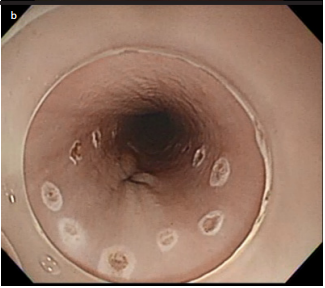Background/Aims: Endoscopic submucosal dissection (ESD) of recurrent esophageal carcinoma is technically difficult to perform due to submucosal fibrosis that develops after definitive chemoradiation therapy. Therefore, our aim was to evaluate the usefulness of clip-with-thread traction for ESD of esophageal lesions with submucosal fibrosis.
Materials and Methods: Four endoscopists excised 16 lesions by ESD in an ex vivo pig training model. Mock lesions (30 mm in diameter) were created, including a 10-mm area of submucosal fibrosis in the center of each lesion. Each endoscopist performed two ESDs with traction (ESD-T) and two without traction (ESD-N). The primary outcome was the time required for submucosal dissection. Secondary outcomes were the rate of en bloc (complete) resection and perforation during the procedure, and the total amount of solution injected.
Results: All esophageal ESDs were completed. The median dissection time was significantly shorter for the ESD-T group (median 12.5 min, interquartile range 10.2-14.5) when comparing to the ESD-N group (median 18.0 min, interquartile range 14.6-19.2) (P=0.040). The en bloc resection rate was 100% in both groups, with a rate of complete resection of 87.5% and a rate of perforation of 37.5% for both groups. The median amount of solution injected was not significantly different between the ESD-T (18.0 ml) and ESD-N (20.5 ml) groups (P=0.526).
Conclusion: Clip-with-thread traction improved the performance of ESD for lesions with submucosal fibrosis. However, the method might not reduce the risk of perforation, which remains an important clinical issue to resolve.
Cite this article as: Esaki M, Minoda Y, Ihara E, et al. Efficacy of traction, using a clip-with-thread, for esophageal endoscopic submucosal dissection for esophageal lesions with fibrosis in an ex vivo pig training model. Turk J Gastroenterol 2020; 31(1): 58-64.




.png)
.png)
